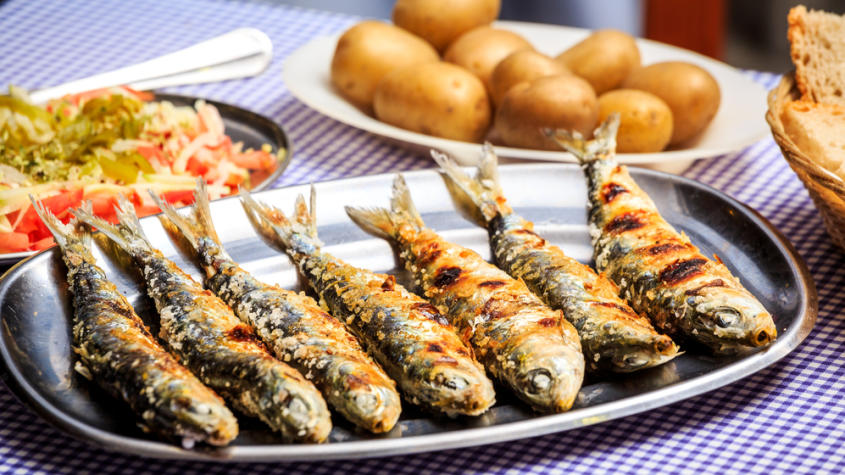
Portugal - A Foodies Paradise!
Portuguese food is Mediterranean cuisine at its best, and like the people, it’s warm, vibrant, spicy, and a little mysterious. It’s also balanced, as the people’s diet is filled with fruits, vegetables, fresh seafood, meat, and plenty of sweets. At the center of every meal are two key ingredients, bread and wine, although most Portuguese would probably argue pork should be included too. Here, we take a look at some of the more popular and mouthwatering Portuguese dishes.
Bacalhau
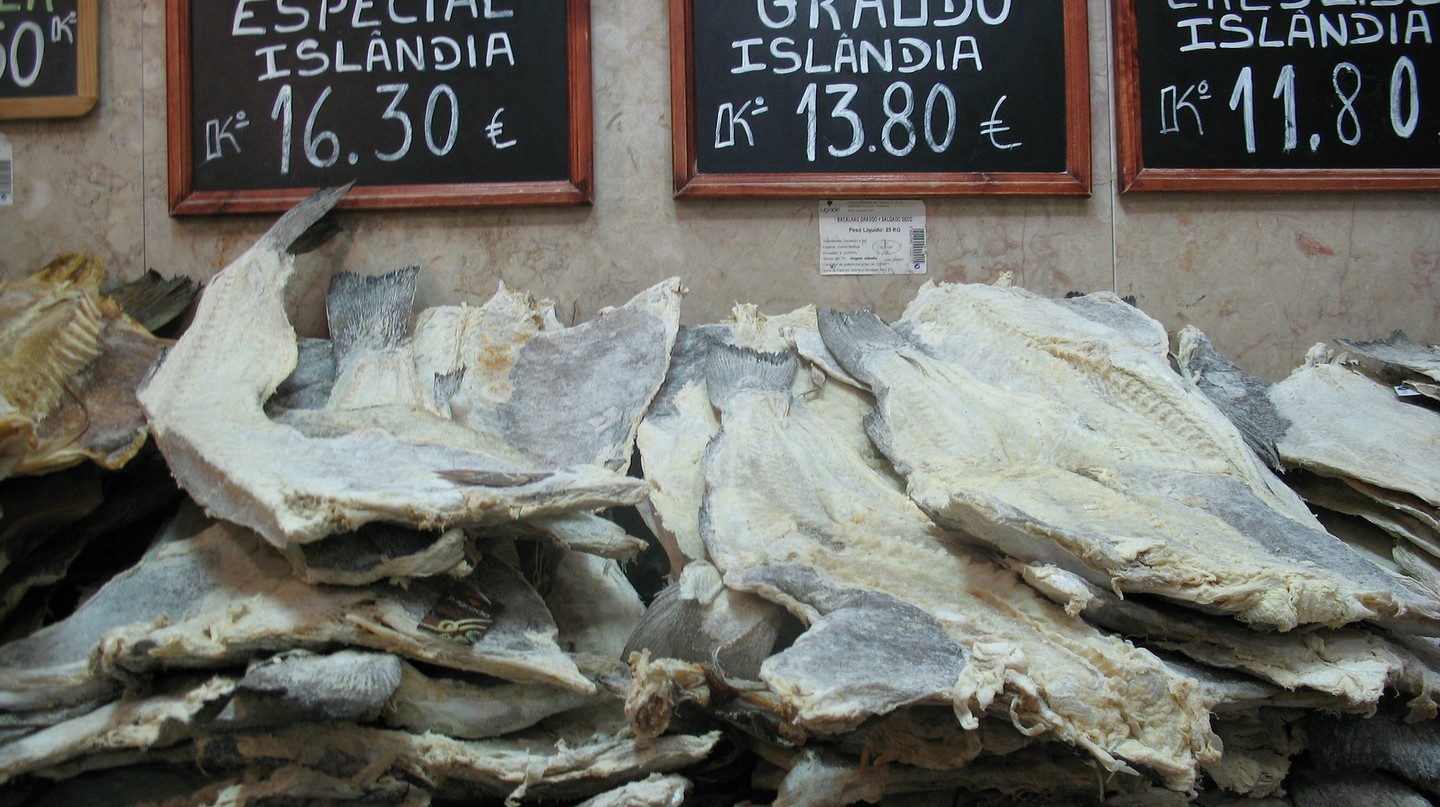 Bacalhau is more than just an iconic Portuguese symbol it is the single most important dish in Portugal. Made from dried, salted cod fished in the cold waters off the coast of Norway, it’s said there are enough recipes for bacalhau that you could cook one every day of the year and never make the same dish twice. Bacalhau was carried on ships to other ports, and the recipe made its way into other cuisines in Galicia in northwest Spain, as well as former Portuguese colonies in Mozambique, Cape Verde, Angola, Macau, Brazil, and Goa. Each region and outpost now has its own specialties, but three well-known examples are bacalhau à Gomes de Sã from Porto, which is salted cod, potatoes, onions, black olives, and hard boiled eggs; Bacalhau com natas, which is salt cod cooked with cream and onion; and Bacalhau à bras from Estremadura, which is salt cod, potato, onion, and scrambled eggs.
Bacalhau is more than just an iconic Portuguese symbol it is the single most important dish in Portugal. Made from dried, salted cod fished in the cold waters off the coast of Norway, it’s said there are enough recipes for bacalhau that you could cook one every day of the year and never make the same dish twice. Bacalhau was carried on ships to other ports, and the recipe made its way into other cuisines in Galicia in northwest Spain, as well as former Portuguese colonies in Mozambique, Cape Verde, Angola, Macau, Brazil, and Goa. Each region and outpost now has its own specialties, but three well-known examples are bacalhau à Gomes de Sã from Porto, which is salted cod, potatoes, onions, black olives, and hard boiled eggs; Bacalhau com natas, which is salt cod cooked with cream and onion; and Bacalhau à bras from Estremadura, which is salt cod, potato, onion, and scrambled eggs.
Cataplana
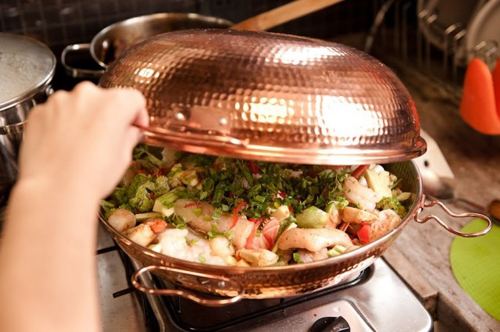 Cataplana is both the name of a regional dish and the pot in which the food is cooked. Despite its simple appearance, the cataplana revolutionized cooking by eliminating the heat and labor involved in cooking over an open flame or in a searing wood oven. Shaped like a round clam shell with a hinged lid, the cataplana was traditionally made of hammered copper but is now often made of non-stick metal. To use a cataplana, the food is placed in the bottom half of the pot, and once the lid is closed it seals in the steam, aromas, and cooking juices during simmering so that intense flavors develop and permeate all the ingredients.
Cataplana is both the name of a regional dish and the pot in which the food is cooked. Despite its simple appearance, the cataplana revolutionized cooking by eliminating the heat and labor involved in cooking over an open flame or in a searing wood oven. Shaped like a round clam shell with a hinged lid, the cataplana was traditionally made of hammered copper but is now often made of non-stick metal. To use a cataplana, the food is placed in the bottom half of the pot, and once the lid is closed it seals in the steam, aromas, and cooking juices during simmering so that intense flavors develop and permeate all the ingredients.
Pork
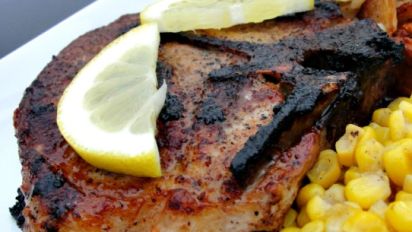 Portugal’s love of pork is so genuine that they eat every part of the pig except the squeal. Pork is used in everything from soups, to grilled kebabs, and even dessert. The passion for pork is so prevalent countrywide there are matanças dos porcos, or pig killing festivals, where every part of the pig is used in some dish. This same love translates to sausages which are prepared in every way imaginable and used in almost any savoury dish.
Portugal’s love of pork is so genuine that they eat every part of the pig except the squeal. Pork is used in everything from soups, to grilled kebabs, and even dessert. The passion for pork is so prevalent countrywide there are matanças dos porcos, or pig killing festivals, where every part of the pig is used in some dish. This same love translates to sausages which are prepared in every way imaginable and used in almost any savoury dish.
Seafood
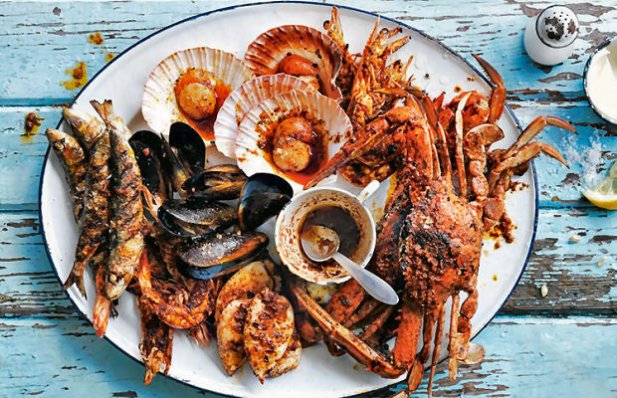 Portugal’s dependence on the sea is evident in the cuisine, and certain regions such as Algarve and Estremadura are renowned for the diversity and quality of their catch. Fresh seafood is often sold right from the boat at the large Cascais fish market in Lisbon. The Portuguese cook hundreds of their favorite fish and seafood options in clean, light, tasty ways that include grilling it over charcoal, baking it, pan-frying it, roasting it in an oven, cooking it in a cataplana, or broiling it.
Portugal’s dependence on the sea is evident in the cuisine, and certain regions such as Algarve and Estremadura are renowned for the diversity and quality of their catch. Fresh seafood is often sold right from the boat at the large Cascais fish market in Lisbon. The Portuguese cook hundreds of their favorite fish and seafood options in clean, light, tasty ways that include grilling it over charcoal, baking it, pan-frying it, roasting it in an oven, cooking it in a cataplana, or broiling it.
Petiscos
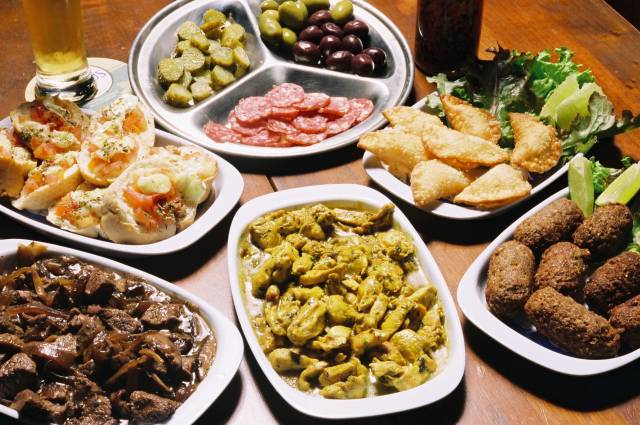 Petiscos, or Portuguese tapas, comes from the verb petiscar, which means “to eat a little of this and that,” and they are a gourmet treat on their own. All over Portugal, there are little taverns that specialize in petiscos, with some focusing on only one regional specialty, and others offering a range of selections. Petiscos is a social offering encouraging groups to sit down and enjoy the flavours together over some wine and good conversation.
Petiscos, or Portuguese tapas, comes from the verb petiscar, which means “to eat a little of this and that,” and they are a gourmet treat on their own. All over Portugal, there are little taverns that specialize in petiscos, with some focusing on only one regional specialty, and others offering a range of selections. Petiscos is a social offering encouraging groups to sit down and enjoy the flavours together over some wine and good conversation.
Spices and Condiments
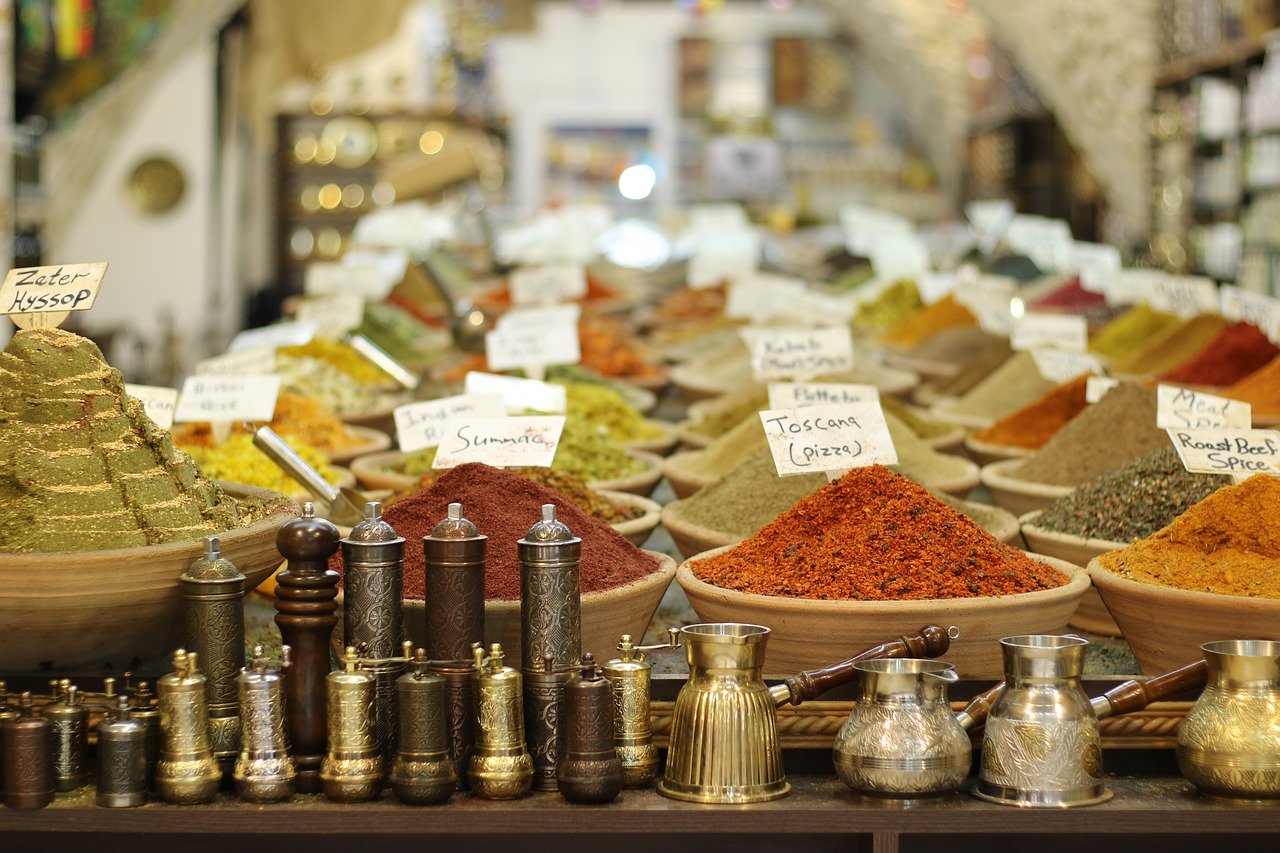 Portuguese spices are the focal point of their unique and full flavoured dishes. From North Africa, the Moors introduced the use of cinnamon, cumin, coriander, parsley, nutmeg, mint, and saffron, and showed the Portuguese how to use a mortar and pestle to grind nuts and other ingredients into a fine paste to use in sauces, syrups, and desserts. However, it was the mouth-searing-hot peri-peri Bird’s Eye pepper that really changes the way things are spiced in Portugal. It has been an essential ingredient in Portuguese food since the fourteenth century, and is used in everything from soups to being slathered on beef, pork, chicken, and shellfish. This beloved hot pepper is most often used as a thick condiment, and thanks to Portuguese traders, its cultivation and use spread to Angola, Mozambique and other parts of the world. Surprisingly, one other big flavour that is used with expertise and finesse is curry, which came by way of Goa. While it is not the predominate flavour in many dishes, savvy cooks use it to add underlying depths of flavour and earthiness to give each dish nuance.
Portuguese spices are the focal point of their unique and full flavoured dishes. From North Africa, the Moors introduced the use of cinnamon, cumin, coriander, parsley, nutmeg, mint, and saffron, and showed the Portuguese how to use a mortar and pestle to grind nuts and other ingredients into a fine paste to use in sauces, syrups, and desserts. However, it was the mouth-searing-hot peri-peri Bird’s Eye pepper that really changes the way things are spiced in Portugal. It has been an essential ingredient in Portuguese food since the fourteenth century, and is used in everything from soups to being slathered on beef, pork, chicken, and shellfish. This beloved hot pepper is most often used as a thick condiment, and thanks to Portuguese traders, its cultivation and use spread to Angola, Mozambique and other parts of the world. Surprisingly, one other big flavour that is used with expertise and finesse is curry, which came by way of Goa. While it is not the predominate flavour in many dishes, savvy cooks use it to add underlying depths of flavour and earthiness to give each dish nuance.
Desserts
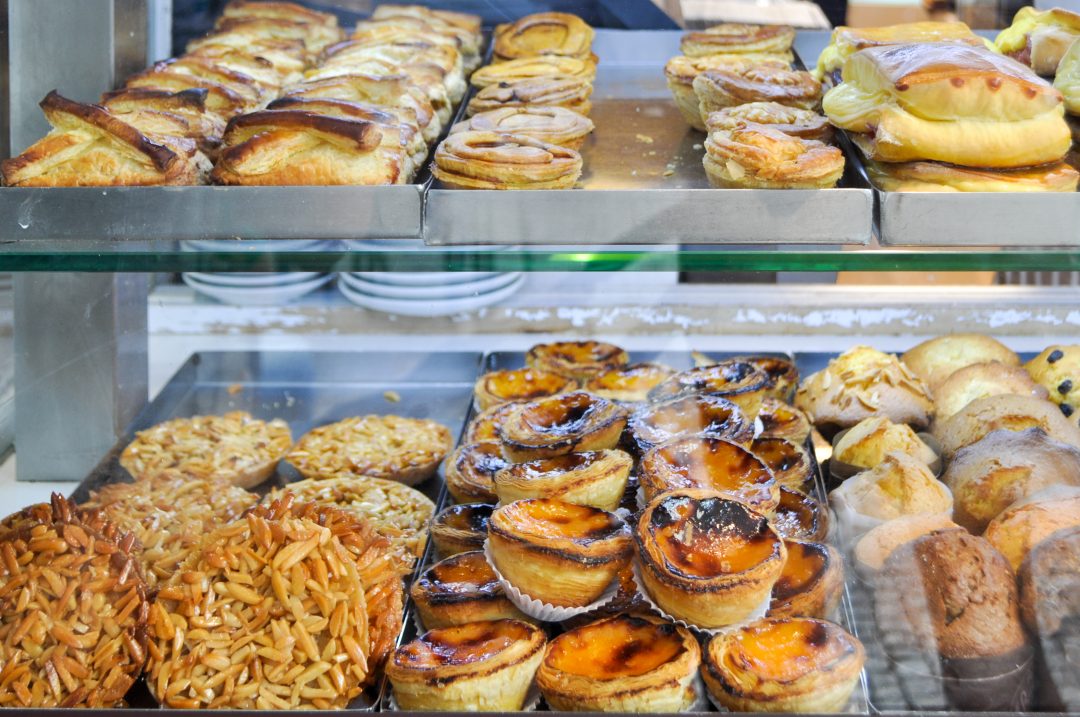 The Portuguese have a sweet tooth, bakers in Portugal make over two hundred different types of pastries, and most of them can trace their origins to the time of the arrival of the Moors, who brought sugar cane with them, and whose laissez-faire attitude toward the Catholic Church allowed convents to develop hundreds of sweet treats. By the sixteenth and seventeenth century, convents were employing women and nuns to make sweets to help support their abbeys and charity work, and sold everything from behind cloistered gates. Even today, many of the desserts still have names with religious connotations like toucinho do céu (heaven's lard) or barriga de freiras (nun's belly). Most popular are egg custards, cinnamon laced treats, and desserts made with nuts and citrus. For a uniquely Portuguese experience, head to a pasteleria or confeitaria to try a pastel de nata, one of the best egg custard tarts you will ever eat.
The Portuguese have a sweet tooth, bakers in Portugal make over two hundred different types of pastries, and most of them can trace their origins to the time of the arrival of the Moors, who brought sugar cane with them, and whose laissez-faire attitude toward the Catholic Church allowed convents to develop hundreds of sweet treats. By the sixteenth and seventeenth century, convents were employing women and nuns to make sweets to help support their abbeys and charity work, and sold everything from behind cloistered gates. Even today, many of the desserts still have names with religious connotations like toucinho do céu (heaven's lard) or barriga de freiras (nun's belly). Most popular are egg custards, cinnamon laced treats, and desserts made with nuts and citrus. For a uniquely Portuguese experience, head to a pasteleria or confeitaria to try a pastel de nata, one of the best egg custard tarts you will ever eat.
Discover the tastes of Portugal on our Portugal 8-Day Guided Food Tour